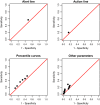Cervical dilatation over time is a poor predictor of severe adverse birth outcomes: a diagnostic accuracy study
- PMID: 29498187
- PMCID: PMC6032950
- DOI: 10.1111/1471-0528.15205
Cervical dilatation over time is a poor predictor of severe adverse birth outcomes: a diagnostic accuracy study
Abstract
Objective: To assess the accuracy of the World Health Organization (WHO) partograph alert line and other candidate predictors in the identification of women at risk of developing severe adverse birth outcomes.
Design: A facility-based, multicentre, prospective cohort study.
Setting: Thirteen maternity hospitals located in Nigeria and Uganda.
Population: A total of 9995 women with spontaneous onset of labour presenting at cervical dilatation of ≤6 cm or undergoing induction of labour.
Methods: Research assistants collected data on sociodemographic, anthropometric, obstetric, and medical characteristics of study participants at hospital admission, multiple assessments during labour, and interventions during labour and childbirth. The alert line and action line, intrapartum monitoring parameters, and customised labour curves were assessed using sensitivity, specificity, positive and negative likelihood ratios, diagnostic odds ratio, and the J statistic.
Outcomes: Severe adverse birth outcomes.
Results: The rate of severe adverse birth outcomes was 2.2% (223 women with severe adverse birth outcomes), the rate of augmentation of labour was 35.1% (3506 women), and the caesarean section rate was 13.2% (1323 women). Forty-nine percent of women in labour crossed the alert line (4163/8489). All reference labour curves had a diagnostic odds ratio ranging from 1.29 to 1.60. The J statistic was less than 10% for all reference curves.
Conclusions: Our findings suggest that labour is an extremely variable phenomenon, and the assessment of cervical dilatation over time is a poor predictor of severe adverse birth outcomes. The validity of a partograph alert line based on the 'one-centimetre per hour' rule should be re-evaluated.
Funding: Bill & Melinda Gates Foundation, United States Agency for International Development (USAID), UNDP/UNFPA/UNICEF/WHO/World Bank Special Programme of Research, Development and Research Training in Human Reproduction (HRP), and WHO (A65879).
Tweetable abstract: The alert line in check: results from a WHO study.
Keywords: alert line; childbirth; diagnostic accuracy; partograph; receiver operating characteristic space.
© 2018 World Health Organization; licensed by John Wiley & Sons Ltd on behalf of Royal College of Obstetricians and Gynaecologists.
Figures



Comment in
-
Cervical dilatation over time is a poor predictor of severe adverse birth outcomes: a call for higher level evidence.BJOG. 2018 Jul;125(8):1000. doi: 10.1111/1471-0528.15213. Epub 2018 Apr 24. BJOG. 2018. PMID: 29520972 No abstract available.
-
Re: Cervical dilatation over time is a poor predictor of severe adverse birth outcomes: a diagnostic accuracy study.BJOG. 2018 Sep;125(10):1341-1342. doi: 10.1111/1471-0528.15323. Epub 2018 Jul 18. BJOG. 2018. PMID: 30022591 No abstract available.
References
-
- de Jonge A, Geerts CC, van der Goes BY, Mol BW, Buitendijk SE, Nijhuis JG. Perinatal mortality and morbidity up to 28 days after birth among 743 070 low‐risk planned home and hospital births: a cohort study based on three merged national perinatal databases. BJOG 2015;122:720–8. - PubMed
-
- Cohen WR, Friedman EA. The assessment of labor: a brief history. J Perinat Med 2018;46:1–8. https://doi.org/10.1515/jpm-2017-0018 - DOI - PubMed
Publication types
MeSH terms
Grants and funding
LinkOut - more resources
Full Text Sources
Other Literature Sources
Medical

